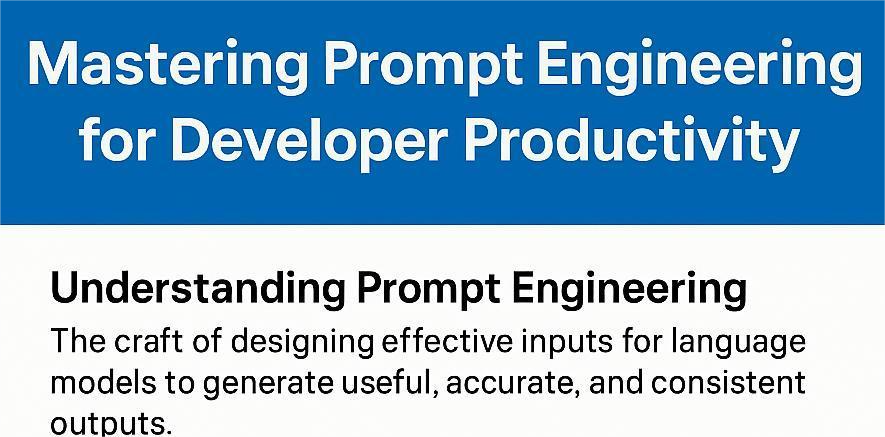
In modern software development, productivity extends beyond writing code. It involves problem-solving, decision-making, and harnessing tools that assist these processes. Among the most impactful recent advancements is integrating large language models (LLMs) into development workflows. At the heart of this integration lies a valuable skill: prompt engineering.
Prompt engineering is designing effective input prompts to guide language models toward useful, accurate, and consistent outputs. With well-structured prompts, developers unlock a wide range of capabilities from LLMs, including code generation, debugging assistance, documentation creation, and architectural guidance. Through this skill, LLMs become intelligent collaborators in the software development process.
Understanding Prompt Engineering
Prompt engineering operates on a simple principle: the quality of input influences the quality of output. Just as precise questions lead to better answers in human conversations, well-formed prompts produce more targeted and reliable responses from an AI model.
Developers use prompt engineering to guide models through coding tasks, technical explanations, and logic formulation. A clear prompt, structured with intent and context, turns the language model into a tool that enhances creativity and accelerates workflows.
Elements of Effective Prompting
To master prompt engineering, one must understand its core elements. These include clarity, context, specificity, and structure.
- Clarity ensures that the model receives a prompt and is free from ambiguity. Clear language, defined objectives, and an organised structure help the model interpret instructions accurately.
- Context provides the model with the necessary background. This might include the programming language, desired output format, or a short snippet of existing code. Context strengthens relevance.
- Specificity narrows the model’s focus. Instead of general requests, prompts that define input types, functions, or modules yield more reliable results.
- Structure shapes the conversation. For example, using a question-and-answer format or breaking tasks into numbered steps creates a logical flow that the model can easily follow.
Applications in Developer Workflows
Prompt engineering opens the door to various applications that improve developer productivity. These include:
1. Code Generation
Developers describe a function or a feature in natural language, and the model generates a matching code block. For example:
“Write a Python function that checks if a string is a palindrome.”
This allows developers to quickly produce boilerplate or repetitive logic, freeing them to focus on more complex or creative challenges.
2. Code Refactoring
Prompting the model with existing code and a desired improvement leads to suggestions for cleaner, more efficient alternatives. A developer might ask:
“Refactor this function to reduce complexity and improve readability.”
This helps maintain code quality across large projects with ease.
3. Documentation Writing
Many tools powered by LLMs assist in writing or enhancing documentation. A simple prompt such as:
“Generate a docstring for the following Python function.”
provides immediate support for better code comprehension, especially in collaborative environments.
4. Error Explanation
When encountering compiler or runtime errors, developers can submit the error message along with a prompt like:
“Explain this error in simple terms and suggest a solution.”
The model offers guidance, reducing time spent on troubleshooting and encouraging independent learning.
5. Unit Test Creation
Automated test generation becomes faster and more systematic with prompt engineering. Developers request:
“Write unit tests in Jest for this JavaScript function.”
The output provides immediate test coverage, ensuring quality assurance remains integral to the process.
Prompt Templates for Reusability
To maintain consistency and improve efficiency, many developers create prompt templates. These templates serve as reusable scaffolds for common tasks such as bug fixes, data validation, or algorithm design.
A prompt template might look like:
“You are a senior developer. Given the following requirement: [insert requirement], write a [language] function that meets it. Include comments for each step.”
Using templates saves time and standardises interactions across teams.
Tools That Support Prompt Engineering
Several platforms incorporate prompt engineering into developer tooling. Extensions for IDEs, such as GitHub Copilot in Visual Studio Code, enable inline prompting. Chat interfaces like those from OpenAI or Hugging Face provide multi-turn conversations for iterative development tasks.
Prompt engineering also integrates into CI/CD workflows, where prompts can trigger code analysis, generate configuration files, or summarize pull requests.
Continuous Improvement Through Iteration
Prompt engineering thrives on iteration. Developers adjust prompts based on previous results, refining them to achieve better outputs. This process strengthens understanding of model behaviour and sharpens communication between the user and the tool.
As developers practice, they develop intuition around model preferences, including ideal formatting, phrasing, and token length. With time, prompting becomes as natural as writing documentation or naming variables.
Future Prospects of Prompt Engineering
In 2025, prompt engineering is a key skill for developers with AI-powered tools. It complements traditional programming by adding a layer of interaction with intelligent systems. As models evolve and become more capable, prompt engineering will remain central to harnessing their full potential.
Prompt engineering supports knowledge transfer, promotes code quality, and enhances developer autonomy in organizations. By fostering clarity in technical communication, it transforms language into a powerful interface for software creation.
Mastering prompt engineering gives developers a strong advantage in the age of AI-assisted development. Developers engage productively with language models through thoughtful, well-designed prompts, solving problems faster and building better software.
With practice and exploration, prompt engineering becomes more than a tool, it becomes an essential part of the developer’s mindset, which values precision, creativity, and collaboration with intelligent systems.
Leave a Reply